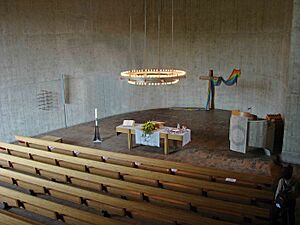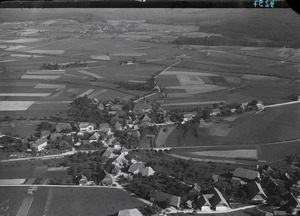Urtenen-Schönbühl facts for kids
Quick facts for kids
Urtenen-Schönbühl
|
||
|---|---|---|
 |
||
|
||
| Country | Switzerland | |
| Canton | Bern | |
| District | Bern-Mittelland | |
| Area | ||
| • Total | 7.19 km2 (2.78 sq mi) | |
| Elevation | 525 m (1,722 ft) | |
| Population
(Dec 2020 )
|
||
| • Total | 6,367 | |
| • Density | 885.5/km2 (2,293.5/sq mi) | |
| Postal code |
3322
|
|
| Localities | Urtenen, Schönbühl | |
| Surrounded by | Ballmoos, Bolligen, Jegenstorf, Mattstetten, Moosseedorf, Wiggiswil | |
| Twin towns | Binn (Switzerland), Dacice (Czech Republic) | |
Urtenen-Schönbühl is a town in Switzerland. It is located in the Bern-Mittelland area of the canton of Bern. A canton is like a state in Switzerland. This town is a great example of how places can change over time, from a small farming village to a busy transport hub.
Contents
History of Urtenen-Schönbühl
The area around Urtenen-Schönbühl has been home to people for a very long time. Scientists have found ancient tools from the neolithic period (New Stone Age) at places called Längenrüpp and Schönbühl. They also found old burial mounds from the Hallstatt culture (an early Iron Age culture) at Sand and other spots. Even ruins from the Roman times were discovered near Moossee.
Early Beginnings of Urtenen
The village of Urtenen was first written about in the year 1249. Back then, it was known as Urtinun. It was owned by a group of powerful nobles called the Counts of Kyburg.
Between 1371 and 1374, wealthy families from Bern bought the village. These families were called patricians, which means they were part of the ruling class. Over the next few centuries, families like the von Diesbach and von Erlach owned parts of the village. The local court, which handled smaller legal cases, used to meet at the tavern in Urtenen.
Changes and Growth in the Village
The town's official symbol, its coat of arms, was first recorded in 1780. It shows a black pointed shape with a white cross on a silver background. After the French invasion in 1798, the old way of governing the area changed. Urtenen became part of the Fraubrunnen district a few years later.
The Urtenen river caused floods in the village in 1780, 1855, and 1917. To stop this, a big project was done in 1944-46. They lowered the river's level and built walls to protect the village from future floods.
During the 1800s, many farmers started raising dairy cows instead of just growing crops. This led to the first village dairy opening in 1842.
Becoming a Transport Hub
For a long time, the main road from Bern to Aargau went around Urtenen. But this changed in the 18th and 19th centuries. From 1845 to 1848, the Bernstrasse was built. This road went right through the village, connecting Urtenen to Bern and Aargau. Other roads soon followed, linking the village to cities like Solothurn and Biel.
Then came the railways! A train line to Olten opened in 1867, and another to Solothurn in 1916. These new roads and railways helped Urtenen grow from a quiet farming village into a major place for transport.
Growth sped up even more in 1962. That's when the A1 and A6 motorways met near Schönbühl. Urtenen, which used to be part of the Jegenstorf church area, got its own church. The new parish church was built between 1965 and 1968.
Modern Urtenen-Schönbühl
The population of the town doubled between the 1970s and 1980s. In 1987, a new town center was built between the old village of Urtenen and the nearby area of Schönbühl. Because of this, people started planning to rename the town to Urtenen-Schönbühl. This new name would show that the town was no longer just about the historical village of Urtenen.
By the year 2000, there were over 3,000 jobs in the town. Even with all this growth, the old village has kept its traditional look. Most of the new homes are in newer areas outside the historic village. The town was officially renamed Urtenen-Schönbühl in 2001.
Geography of Urtenen-Schönbühl
Urtenen-Schönbühl covers an area of about 7.2 square kilometers (2.8 square miles). A large part of this land, about 44.3%, is used for farming. Forests cover about 30.2% of the area. About 20.2% of the land has buildings or roads on it. A small part, about 3.1%, is covered by rivers or lakes.
The town is located in the valley of the Urtenen river. It includes the main village of Urtenen, the neighborhood of Schönbühl, and part of Krauchthalerbergen.
On December 31, 2009, the old district of Fraubrunnen, where Urtenen-Schönbühl was located, was closed. The next day, January 1, 2010, the town became part of the new Bern-Mittelland administrative district.
Population and People
Urtenen-Schönbühl has a population of about 5,741 people as of 2011. In 2010, about 16.3% of the people living there were foreign nationals. Over the past ten years (2000-2010), the population grew by 9.3%. This growth was partly due to people moving into the town and partly from more births than deaths.
Most people in Urtenen-Schönbühl speak German as their first language (about 87.4% in 2000). Other languages spoken include Serbo-Croatian (2.6%) and Italian (1.6%).
In 2008, about 48.7% of the population was male and 51.3% was female. Most residents were Swiss citizens. About 18.5% of the people living in Urtenen-Schönbühl in 2000 were born there. Many others were born in the same canton (44.6%) or elsewhere in Switzerland (14.9%). About 17.1% were born outside of Switzerland.
In 2010, children and teenagers (ages 0-19) made up about 19.9% of the population. Adults (20-64 years old) made up 65.8%, and seniors (over 64 years old) made up 14.3%.
The number of people living in Urtenen-Schönbühl has changed over time. Here's how the population has grown:

Economy and Jobs
In 2011, Urtenen-Schönbühl had a low unemployment rate of 2.74%. This means most people who wanted jobs had them. In 2008, there were 2,176 people working in the town.
Jobs are usually divided into three main types:
- Primary sector: This includes jobs like farming and fishing. In 2008, about 51 people worked in this sector, mostly in agriculture.
- Secondary sector: This includes jobs in manufacturing and construction. About 607 people worked in this sector. Most of them (69.4%) were in manufacturing, making things.
- Tertiary sector: This includes jobs that provide services, like shops, hospitals, and schools. This was the largest sector, with 1,518 people working in it. Many worked in sales, transportation, hotels, or healthcare.
In 2000, about 2,007 workers came into Urtenen-Schönbühl for their jobs. However, 2,432 workers left the town to work elsewhere. This means more people leave to work than come in. About 31.4% of working people used public transport to get to work, and 44.3% used a private car.
Religion in Urtenen-Schönbühl
According to the 2000 census, many people in Urtenen-Schönbühl belong to Christian churches. About 16.0% were Roman Catholic, and 59.8% belonged to the Swiss Reformed Church. There were also people who were Orthodox Christians (2.36%) and other Christian groups.
About 4.25% of the population was Islamic. There were also people who followed Buddhism and Hinduism. About 7.80% of the population said they did not belong to any church, or were agnostic (not sure if God exists) or atheist (do not believe in God).
Education and Schools
In Urtenen-Schönbühl, about 42.6% of the population has finished non-mandatory upper secondary education. This is like high school. Also, about 11.7% have gone on to higher education, like a university or a specialized college.
The school system in the Canton of Bern works like this:
- One year of optional Kindergarten.
- Six years of Primary school.
- Three years of mandatory lower Secondary school. In this stage, students are grouped by their abilities.
After lower Secondary school, students can choose to continue their education or start an apprenticeship (learning a trade on the job).
During the 2010-2011 school year, there were 559 students in Urtenen-Schönbühl.
- There were 6 kindergarten classes with 122 students.
- There were 15 primary classes with 277 students.
- There were 11 lower secondary classes with 160 students.
Many students in these classes were either not Swiss citizens or spoke a different language at home than the one used in the classroom.
In 2000, 34 students came from other towns to study in Urtenen-Schönbühl. At the same time, 140 students from Urtenen-Schönbühl went to schools outside the town.
Transportation Links
Urtenen-Schönbühl has good transport connections, especially by train. The town has three railway stations:
- Schönbühl SBB station is on the standard-sized Olten–Bern line.
- Schönbühl RBS and Urtenen stations are on the narrower-gauge Solothurn–Worblaufen line.
These train lines help people travel easily to and from Urtenen-Schönbühl.
See also
 In Spanish: Urtenen-Schönbühl para niños
In Spanish: Urtenen-Schönbühl para niños









